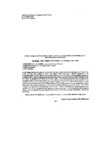Use este identificador para citar ou linkar para este item:
http://www.alice.cnptia.embrapa.br/alice/handle/doc/12036Registro completo de metadados
| Campo DC | Valor | Idioma |
|---|---|---|
| dc.contributor.author | MORAES, I. O. | pt_BR |
| dc.contributor.author | CAPALBO, D. M. F. | pt_BR |
| dc.contributor.author | MORAES, R. O. | pt_BR |
| dc.contributor.author | BIANCHI, V. L. del | pt_BR |
| dc.contributor.author | CONTI, H. H. | pt_BR |
| dc.date.accessioned | 2017-02-16T22:45:04Z | - |
| dc.date.available | 2017-02-16T22:45:04Z | - |
| dc.date.created | 1994-06-29 | pt_BR |
| dc.date.issued | 1994 | pt_BR |
| dc.identifier.citation | In: INTERNATIONAL MEETING ON CASSAVA FLOUR AND STARCH, 1994, Cali. Abstracts. Cali: CIAT, 1994. | pt_BR |
| dc.identifier.uri | http://www.alice.cnptia.embrapa.br/alice/handle/doc/12036 | pt_BR |
| dc.description | In developing countries the search for inexpensive substrates to grow useful microorganisms is a desirable way to get new and safe products to protect man against insect pest losses. Bacillus thuringiensis is an entomopathogenic bacteria, which by fermentation produces endo- or exotoxins to be used against Lepidoptera or Diptera, resp. These are insect pests of economic importance in developing countries, mainly in Brazil, where 60% losses in agriculture are caused by this type of pest. Our research group has been working with B. thuringiensis since 1970; and many papers have been published on the processes, culture media composition and available substrates, culture and operational conditions, equipment and so on. Many residues and waste waters were tried forthe fermentation culture medium. This paper reports the possibility of using manipueira, a residual waste water from cassava processing as a substrate to produce B. thuringiensis by fermentation. The culture medium was composed of 75% manipueira & 25% water. Operational conditions considered agitation and aeration rate, as well as initial pH and optimum growing temperature. Microbial growth and sporulation behavior were accomplished by optical density determination, pH variation and sugar consumption. Results are promising. | pt_BR |
| dc.language.iso | eng | eng |
| dc.rights | openAccess | eng |
| dc.subject | Production | pt_BR |
| dc.subject | Residues | pt_BR |
| dc.subject | Substrates | pt_BR |
| dc.subject | Substrato | pt_BR |
| dc.title | Bacillus thuringiensis production using cassava liquid waste (manipueira) as a fermentation substrate. | pt_BR |
| dc.type | Resumo em anais e proceedings | pt_BR |
| dc.date.updated | 2017-02-16T22:45:04Z | pt_BR |
| dc.subject.thesagro | Bacillus Thuringiensis | pt_BR |
| dc.subject.thesagro | Fermentação | pt_BR |
| dc.subject.thesagro | Mandioca | pt_BR |
| dc.subject.thesagro | Manipueira | pt_BR |
| dc.subject.thesagro | Resíduo | pt_BR |
| dc.subject.thesagro | Produção | pt_BR |
| dc.subject.nalthesaurus | Manihot | pt_BR |
| dc.subject.nalthesaurus | fermentation | pt_BR |
| dc.format.extent2 | p.124 | pt_BR |
| riaa.ainfo.id | 12036 | pt_BR |
| riaa.ainfo.lastupdate | 2017-02-16 | pt_BR |
| dc.contributor.institution | IRACEMA O. MORAES, UNESP; DEISE MARIA FONTANA CAPALBO, CNPMA; UNESP; UNESP; CNPQ. | pt_BR |
| Aparece nas coleções: | Resumo em anais de congresso (CNPMA)  | |
Arquivos associados a este item:
| Arquivo | Descrição | Tamanho | Formato | |
|---|---|---|---|---|
| 1994PL010CapalboBacillus2660.PDF | 651,24 kB | Adobe PDF |  Visualizar/Abrir |









